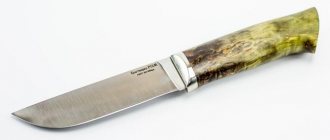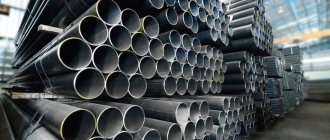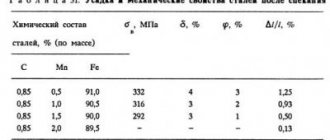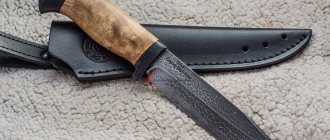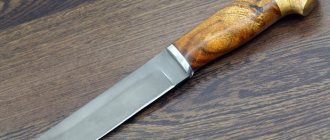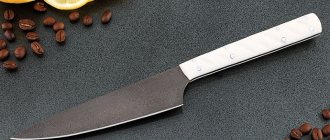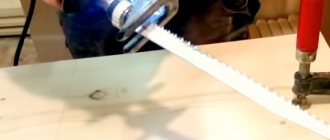Resistance to rust, dullness, and mechanical damage depends on the quality of heat treatment and alloy composition of knife blades. When choosing the best steel for a knife, the purpose of the product is taken into account: for use in the kitchen or in camping conditions, a different combination of characteristics plays a role.
The steel for the knife must be hard (55 units), durable and resistant to corrosion processes.
What criteria must steel meet?
Different types of steel have different technological and mechanical properties due to the presence of alloying elements in the alloy.
Material for making knives is assessed according to the following criteria:
- Resistant to a wide temperature range (-30…+100°C).
- Sensitivity to corrosion.
- Strength, elasticity. When using the product, minimal deformation of the metal and resistance to longitudinal deflection are important.
- Hardness. The indicator is denoted by the abbreviation HRC (in Europe - RC), assessed on the Rockwell scale. For knives, an indicator above 55 units is considered optimal. As hardness increases, chip resistance decreases.
- Holding an edge. The harder the material, the less often the blade becomes dull.
Another criterion is the ease of sharpening the blade. The softer the material, the easier it is to sharpen (the steel dulls faster). Therefore, a balance between hardness and strength is important.
There is no clear answer to the question of which steel is the best. Priority characteristics should ensure the functionality of the knife to perform the assigned tasks.
Composition and additives
Pieces of high carbon 1095 steel and 15n20 steel with a lot of nickel.
Steel is an alloy of iron and carbon. The rigidity of the material depends on the last element.
The following types of steel are distinguished:
- low carbon;
- medium carbon;
- high carbon.
Knives made of unalloyed steel (without additives) are flexible, but are susceptible to corrosion and are not resistant to damage. To improve the characteristics of the metal, impurities are added to the alloy. The table provides a list of additives used (brief explanations of their functions).
| Element | Functions |
| Manganese (Mn) | Provides strength, allows you to make any blade shape. Present in most steel alloys. |
| Molybdenum (Mo) | Allows you to harden steel to a high level of hardness, makes the blade heat-resistant, and reduces the fragility of the blade. |
| Chromium (Cr) | Protects against the effects of rust. |
| Vanadium (V) | Responsible for resistance to chemicals and increases elasticity. Increases the service life of the product. |
| Silicon (Si) | Reduces the material's susceptibility to mechanical stress, increasing strength. |
| Nickel (Ni) | Prevents steel from rotting and increases corrosion resistance. |
| Tungsten (W) | Increases strength and enhances anti-corrosion properties. |
Sulfur and phosphorus are considered technological impurities. The first element reduces the hardness and strength of the metal; in high-quality alloys the percentage does not exceed 0.065. Phosphorus increases the brittleness of steel. This element is present in all alloys, but the maximum level of the substance in the alloy is 0.045%.
The best foreign steel grades
Different brands of steel have different performance characteristics, all types have pros and cons.
D2
This is a German brand of high quality tool steel, characterized by uniform structure after hardening. One of the most sought after in the world.
Products made from German D2 steel for knives are distinguished by their homogeneous structure.
Advantages:
- sharpening retention;
- cut quality;
- resistance to corrosion and deformation.
D2 steel is a high-carbon type. Designed to create cutting teeth, used in the manufacture of hunting knives.
Contains a large amount of chromium (up to 14%). Hardened (55-69 HRC). At a low cost, it is hard, but difficult to sharpen.
To extend the service life, it is recommended to wipe the blade after contact with water.
CPM S35VN
The brand of the American company belongs to the premium class, characterized by hardness and wear resistance. The abbreviation CPM is the name of the Crucible Particle Metallurgy technology.
The alloy is produced by the powder method, which involves the following steps:
- The liquid melt is cooled with nitrogen, it crystallizes and turns into powder.
- The dry matter is subjected to high temperatures and pressure to sinter the powder.
- The alloy is pressed to produce the finished product.
Strength is ensured by chromium, niobium and vanadium carbides evenly distributed in the powder.
Knives made from American steel CPM S35VN retain their edge well, but are not resistant to bending.
The S35VN grade is an improved version of S30V (niobium is added to the alloy, and fine structure powder is used in production).
The combination of alloyed elements made it possible to improve the characteristics of steel without loss of strength, i.e.:
- Thanks to the fine-grained structure of the material, the product retains its sharpness for a long time and is less susceptible to chipping compared to the previous brand.
- The blade can withstand impact loads.
- Steel is less susceptible to rotting.
- The alloy is characterized by ductility.
The disadvantages of the brand include difficulty in sharpening and high cost. Such blades are not intended for cutting hard surfaces and are not resistant to bending (the hardness of the blade ranges from 58 to 62 on the Rockwell scale).
440C
It is considered a classic knife steel in Europe and America; it contains increased amounts of chromium and carbon.
Knives made of 440C steel are very rust-resistant.
Main characteristics:
- hardness is 59 HRC;
- withstands bending and twisting (can be used when cutting hard, dense products);
- belongs to the stainless steel type (suitable for scuba divers and fishermen);
- holds an edge;
- easy to edit.
Classic and folding knife models are made from 440C steel. Products require regular maintenance . Due to the absence of vanadium in the alloy, the blades are not wear-resistant. Compared to premium products, they are sensitive to salts and acids.
Elmax
Swedish steel is produced using powder technology. It is high-carbon, high-alloy. Used for making knives of a high price category. It has good cutting ability.
Products made from Swedish high-carbon steel Elmax are very durable and resistant to corrosion.
Benefits include:
- hardenability (58-62 on the Rockwell scale);
- plastic;
- impact resistance;
- wear resistance;
- corrosion resistance.
With high hardness, steel lends itself well to sharpening. To maintain anti-corrosion properties, regular grinding and polishing of the blade is necessary.
M390
The M390 brand developed by the Austrian metallurgical concern is one of the best. Characterized by resistance to rotting. It was conceived as a material for medical instruments, so special attention during development was paid to the ability to hold an edge.
The blades retain their edge sharpness for up to 6 months. The alloy has a low difference between ultimate yield and tensile strength. The material does not collapse when interacting with most types of alkalis and acids.
The main advantage is the hardness of 60 to 62 HRC. With this indicator, it is possible to polish the canvas to a mirror finish. Sharpening requires a tabletop machine.
ZDP 189
The ZDP 189 brand belongs to a Japanese corporation. This ultra-high carbon tool steel, with a hardness of up to 69 HRC, contains a high percentage of chromium. Developed based on powder technology.
It is distinguished by its cutting qualities and is used for the manufacture of limited series of blades. Due to its fragility, it is not suitable for all blade shapes (for example, not recommended for concave bevels). The canvas is sensitive to impact. The blade can be polished well.
VG-10
Co and Mo make VG-10 viscous and hard.
Alloyed with cobalt and molybdenum, the Japanese grade VG-10 is distinguished by its sharp cutting edge, hardness, resistance to impact loads, and anti-corrosion properties.
It is often used as the central layer of the blade to provide the blade with resistance to rust and improve cutting properties.
The cobalt content of the alloy makes the steel tough and hard. The cutting edge is maintained even at a hardness of 60-62 HRC. The quality of the material is maintained by a special heat treatment method, which the manufacturer keeps secret.
CPM S30V
American powder grade CPM S30V contains from 13 to 18% chromium, is durable and rust-resistant. The alloy contains vanadium and chromium carbides; there are areas of ultra-high hardness on the cutting edge.
The material combines impact strength and wear resistance, and is fracture resistant. The blades have a hardness of up to 58-61 HRC, and are easy to edit.
AUS-8
AUS 8 steel is often used to make kitchen knives of various sizes.
Japanese-made AUS-8 steel has high performance characteristics. The presence of molybdenum and nickel in the alloy provides corrosion resistance.
The smelting and hardening process does not use expensive technologies, so the metal has a low cost.
Blades made from this material do not require special care, combine hardness and elasticity, and are easy to sharpen.
Classification by degree of deoxidation
Deoxidation is a process that leads to a decrease in the oxygen content in the melt. This process is necessary in order to avoid the appearance of rust on rolled metal. The degree of deoxidation provides for the following classification:
- calm (SP) - have a homogeneous structure, contain a minimum amount of gases and non-metals; used for expensive alloys and the manufacture of metal structures;
- semi-quiet (PS) - their properties make it possible to produce load-bearing elements of welded and riveted structures; Bolts and nuts are made from PS, which can be used at low air humidity and high temperature;
- boiling steel (KP) – a brittle type of steel; suitable for the production of boiler parts and structures in contact with explosive substances; The main disadvantage is the rapid appearance of rust.
The following additives usually participate in the deoxidation reaction: aluminum, manganese, silicon.
The best domestic types of steel
The marking of two numbers and the letter “X” indicates the percentage content (in hundredths) of carbon and chromium (the first number is carbon, the second is chromium). Actual figures may vary slightly. We can highlight the top 5 best knife steels from domestic manufacturers.
50x14MF
Universal steel 50x14MF, with which weapons production began. Used in the manufacture of knives and medical instruments. The alloy is resistant to chemical and humid environments. Hardness can be up to 57-58 HRC.
The blades hold their sharpness for a long time, are resistant to shock loads, and can be easily straightened at home.
Steel 50x14MF is universal and suitable for forging knives and axes, as well as for the manufacture of medical equipment.
40Х12
This is a soft, high-alloy steel used in the production of inexpensive knives and souvenir blades. It does not lend itself well to hardening, so the blades bend easily, and the cutting edge almost does not hold an edge.
The advantage is resistance to corrosion. The hardness of the material is 51 or 52 HRC.
X12MF
Initially developed for use in the mechanical engineering industry. The brand is widely used in the manufacture of knives. The alloy contains recycled materials, which reduces production costs.
X12MF steel does not require complex maintenance, belongs to the group of corrosion-resistant materials, and is flexible during processing. The cutting edge is wear resistant. The sharpness of the blade is maintained for a long time. The hardness can reach 64 HRC.
Disadvantages include: sensitivity to bending and acidic environments, the need for special equipment for sharpening, dull appearance of the blade.
95Х18
Often used to make blades. The material is resistant to corrosion, durable, and does not wear out for a long time. The advantage is the ease of sharpening the blade, the disadvantage is the average aggressiveness of the cut. Hardened to 58 HRC.
Read more in the article: “Characteristics of steel for knives 95x18“
65Х13
Refers to inexpensive brands. It is resistant to rust due to its chromium content. Hardness ranges from 56 to 59 units. according to the Rockwell scale. The fabric is resistant to impacts and deformation. Another advantage is ease of operation and sharpening.
Disadvantages include high abrasion rates.
More details in the article: “Characteristics of steel grade 65X13“.
Small knives
This class includes instruments with a short blade and a small handle. The shape of the blade can vary from slightly rounded to claw-shaped (rounded in the opposite direction). Small knives of traditional shapes are perfect for those jobs where a large “Chef” or “Santoku” would look awkward. Tools with a claw blade are most often used for peeling round vegetables and some types of delicacies.
Which steel is better to choose
When choosing a kitchen knife or hunting blade, the quality of the material and the reputation of the manufacturer are taken into account.
For kitchen knives
To be used in the kitchen, a knife must be durable. An important parameter is the quality of the cut. The blades should be easy to sharpen, but not require frequent editing.
The best kitchen knives meet the following parameters:
- rust resistant;
- do not crumble;
- have a homogeneous fabric without streaks or bubbles.
Another parameter is the absence of irregularities on the cutting edge.
Kitchen knife made of steel 65Х13 with chromium content.
In Russia, the following brands are most often used for kitchen knives:
- 65Х13;
- 40X12;
- 95X18;
- 50Х14МФ.
Among foreign brands, 440C steel has a high rating. For kitchen knives, Japanese steels AUS10 and ATS34, as well as American grade 154 CM (USA), are recommended. Steel 420 is often used by foreign manufacturers, but preference should be given to manufacturers from the USA, Switzerland, Austria, and Germany.
Spanish knives made of 420 steel are soft. In European versions, a massive blade is often found, which makes it difficult to accurately cut food.
For hunting knives
Tourist and hunting blades must be made of durable material.
Examples of knives made of steel 95X18.
Brands often used:
- 420 (inexpensive models);
- 440A, B, C;
- AUS 4-10;
- Elmax;
- 95X18;
- H1 (American chromium-nickel steel).
The blade must have different cutting characteristics, remain sharp for a long time, be durable, and not crumble. Alloys with a hardness below 55 and above 60 units are not suitable for a hunting knife. according to the Rockwell scale. In the first case, the canvas will quickly lose its sharpness, in the second, it will be difficult to straighten. Material with a higher hardness rating may break.
Santoku bōchō
The Japanese equivalent of "Chief". Its name is translated into Russian as “three ways of use.” This suggests that the Santoku performs well three main functions: chopping, slicing and crumbling food. Unlike the “Chef”, the blade of this knife has only a slightly rounded shape. However, it does not interfere with quickly shredding and cutting food - the main thing is to get used to the features of the tool.
Properties of powder steel
The powder steel manufacturing process comes down to the basic steps: production and mixing of powders, compaction and sintering. Manufacturers may have different process specifications.
Knives made of this steel are more expensive. The quality of the finished product depends on the size and distribution of the carbides formed. Using the technique allows manufacturers to obtain a high-tech alloy, increase the number of alloyed elements, and improve the characteristics of the material.
Most military and hunting knives are made using powder technology, because... in these cases, increased strength is required in combination with anti-corrosion properties.
Powdered steel blades are sharper than solid metal prototypes. Withstands temperature changes, is resistant to deformation, and can be sanded. The cutting edge retains its sharpness for a long time.
At home, powder steel requires careful sharpening.
Gastronomic knife (SLICER, CARVING)
Gastronomic knives are great for slicing a variety of foods into thin slices. They have a long, stiff and rather narrow blade. The functionality of the “slicer” depends on the quality of the steel and sharpening. Cheap brands of kitchen knives tend to offer tools made from materials that are not hard enough and are not suitable for fine slicing. Therefore, as with a chef's knife, it is recommended to choose a slicer made of high-strength stainless steel, despite the fact that the price of such products can be quite light on the pocket.
Is Damascus steel really that good?
High-quality Damascus steel surpasses many brands in cutting characteristics.
The pattern on the knife blade is characteristic of Damascus steel due to the special process used to prepare the steel plate.
A special technology is used in production:
- Soft and hard types of steel are collected.
- The steel package is heated to forging temperature.
- Special additives are applied (to improve welding between the plates).
- The package is repeatedly pierced with a hammer and sent to the forge.
- When the plate is formed, it warms up. It is chopped into several pieces, which are again collected into a bag.
- The cycle repeats.
The number of repetitions can be from 3 to 10. The more there are, the better the quality of the steel. The properties of the blade are affected by the ratio of soft and hard steels. There should be more of the latter.
Damascus alloy has a hardness of 60 HRC, is distinguished by its strength and sharp edge. Another benefit is cutting performance retention. Products are often decorated with patterns formed due to the heterogeneous structure.
The material has a big drawback: it is not resistant to rust and requires careful care.
To maintain performance and appearance, protection from moisture is necessary; the blade must be wiped after use and treated with special oil.
Therefore, today Damascus steel is inferior to most modern alloys.
Previous
KnivesKnife for hunting: 10 best hunting blades and selection rules
Next
Sharpening knivesThe best knife sharpeners
Main varieties
It is difficult for an inexperienced buyer to decide on the choice of steel grade for a knife. Which is better and what are its advantages is a complex question that requires detailed consideration. However, most people are familiar with popular names such as damask steel and damascus steel, which were often found in action films or adventure books. Both varieties are characterized by unique properties that make them something of a legend.
If we consider the damask version, it was often mentioned in epics and tales about great heroes. The alloy consists of complex carbon compounds and small fractions of iron. It is distinguished by the presence of a specific pattern and fibrous structure. A damask knife, created using appropriate technology, is a strong tool with excellent strength and cutting properties. It can be used both for kitchen work and for hunting or fishing.
The Damascus variety is also surrounded by numerous myths, fairy tales and legends. This alloy has an attractive pattern and consists of iron with a predominance of carbon. The composite elements used make the knife flexible and durable. But the key difference between this type of steel is the specific pattern formed as a result of chaotic mixing of layers.
Most modern manufacturers use powder, Japanese, carbon, Russian and Chinese varieties of steel. All of the listed options differ from each other by specific features, on which the scope of their application and the cost of the final product depend. It is problematic to call one of the options the best, because everything is learned by comparison.

